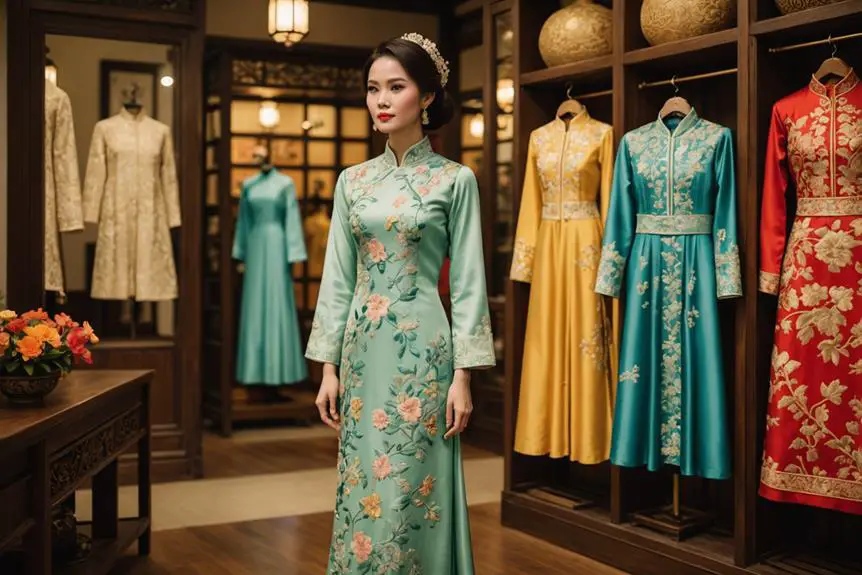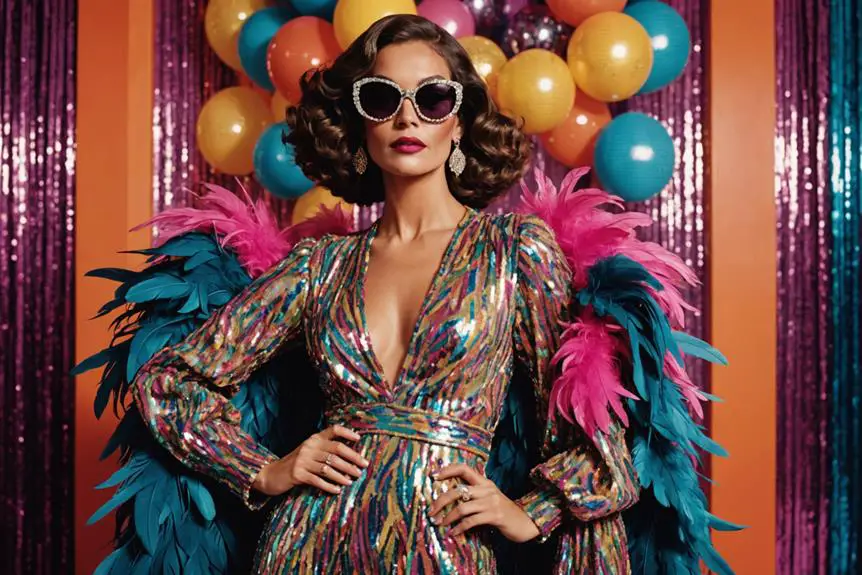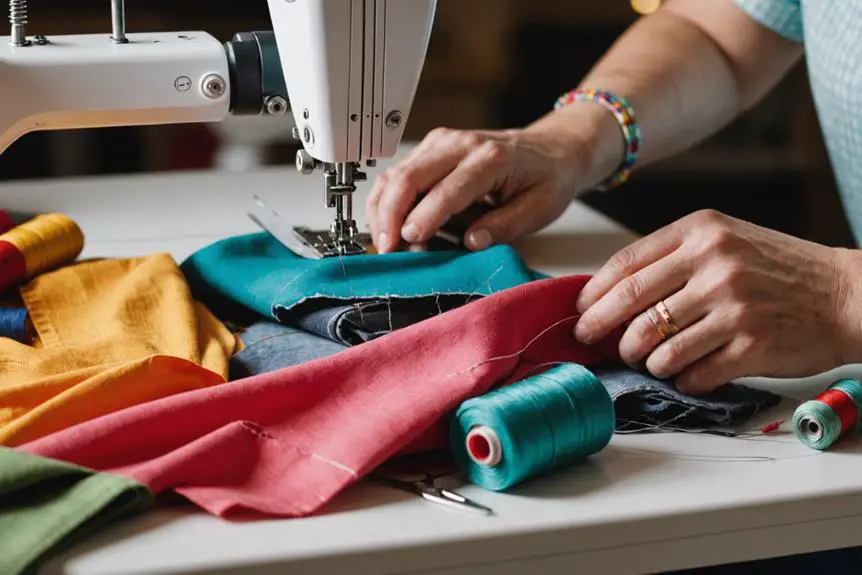Vietnam's oldest fashion brands, like Viet Tien, founded in 1970, and May 10, established in 1989, showcase a vibrant legacy of craftsmanship and cultural pride. Viet Tien, with an impressive revenue of VND 8,464 billion in 2022, remains a market leader. These brands intertwine traditional elements, such as the iconic Ao Dai, with contemporary styles, reflecting the nation's rich cultural tapestry. As the fashion industry evolves, companies like An Phuoc and NEM continue to innovate while honoring their roots. Excitingly, this mixture of tradition and modernity contributes to Vietnam's growing prominence in the global fashion scene, revealing even more fascinating insights ahead.
Historical Background of Vietnamese Fashion
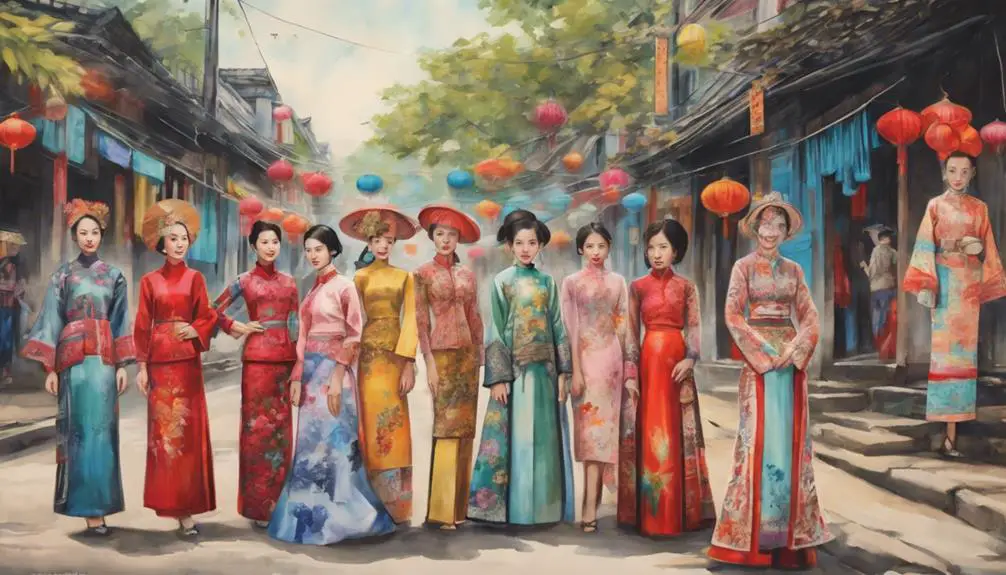
In Vietnam, the fashion industry has roots that stretch back to the early 20th century, where traditional garments like the Ao Dai emerged as symbols of national identity and cultural pride. This elegant attire embodies the rich history of Vietnamese fashion, reflecting the intricate connection between clothing and societal values. In feudal Vietnam, dress codes dictated styles based on social status, with peasants wearing simple garments while aristocrats adorned themselves in luxurious attire, showcasing the diversity and hierarchy within the culture.
As colonial influences seeped into Vietnam, Western fashion elements began to blend with traditional costumes, creating a unique fusion that started shaping Vietnamese fashion in the 20th century. This evolution paved the way for the modern textile sector, which saw the emergence of historical brands like Vinatex, founded in 1995. Vinatex played an essential role in establishing Vietnam as a key player in global fashion supply chains, contributing to the country's growing reputation in the industry.
Today, there's a resurgence of interest in traditional Vietnamese clothing, sparking a revival of ancient costumes. Brands like Great Vietnam focus on researching and recreating these historical garments, making them relevant for contemporary use. This revitalization not only highlights the beauty and craftsmanship of traditional attire but also reinforces cultural pride among the Vietnamese people. By embracing their fashion heritage, you're not just wearing clothes; you're participating in a vibrant cultural narrative that continues to evolve and inspire.
Iconic Vietnamese Fashion Brands
Vietnam's fashion landscape boasts a rich tapestry of iconic brands that have shaped its identity over the decades. Among these, Viet Tien stands out as one of the oldest Vietnamese fashion brands, making waves in the textile industry since 1970. With a remarkable revenue recovery of VND 8,464 billion in 2022, it showcases resilience and relevance in a dynamically evolving market.
Another key player is May 10, founded in 1989, which has firmly established itself within the domestic fashion market, achieving an impressive revenue of VND 4,500 billion last year. This brand continues to resonate with consumers, offering stylish options that cater to various tastes.
When it comes to men's fashion, An Phuoc deserves a mention, specializing in high-quality apparel that reflects contemporary trends. With a profit after tax of VND 588 billion in 2022, it proves that classic tailoring still captivates discerning customers.
In the domain of women's fashion, NEM, launched in 2002, demonstrates adaptability by focusing on the needs of customers aged 25 and older, ensuring its offerings remain fresh and appealing.
Lastly, Blue Exchange stands out for its affordable fashion offerings, boasting over 300 stores across Vietnam. This impressive reach solidifies its status as a prominent brand in the local fashion landscape, making stylish clothing accessible to all. Collectively, these iconic Vietnamese fashion brands not only celebrate the nation's heritage but also pave the way for a vibrant future in the textile industry.
Cultural Influence on Fashion
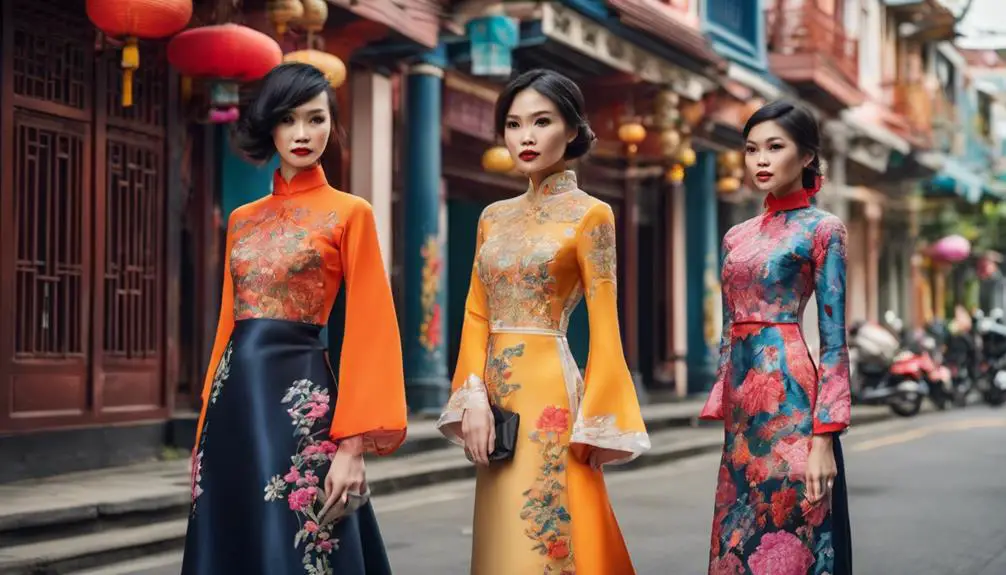
Fashion in Vietnam is deeply rooted in its cultural heritage, with traditional garments like the Ao Dai playing a pivotal role in shaping modern trends. This iconic outfit symbolizes Vietnamese cultural pride, showcasing the beauty of its heritage while adapting to contemporary styles. The rich diversity of Vietnam's 54 ethnic minorities adds a vibrant layer to the fashion scene, inspiring designers to incorporate various traditional Vietnamese elements into their collections.
Here are some key influences shaping Vietnamese fashion today:
- Diverse Ethnic Costumes: Each ethnic group contributes unique patterns and textiles, enriching the overall aesthetic.
- Heritage Brands: Labels like Subtle Le Nguyen focus on community and craftsmanship, honoring local artisans.
- Revival of Traditional Attire: Initiatives like Great Vietnam aim to correct misconceptions about ancient garments, promoting them in modern contexts.
- Modern-Motif Blending: Emerging designers mix traditional motifs with contemporary sensibilities, creating innovative pieces that resonate with younger audiences.
- Cultural Narratives: Designers draw from Vietnam's historical and cultural stories, weaving them into their creations for deeper meaning.
As you explore this fashion landscape, you'll notice how these influences combine to create a unique fusion that celebrates Vietnam's rich cultural tapestry. The evolution of Vietnamese fashion brands reflects a commitment to sustainability and authenticity, inviting you to embrace both the past and the future in every stylish piece.
Evolution of Traditional Attire
When you explore the evolution of traditional Vietnamese attire, you'll uncover a fascinating journey that mirrors the country's rich cultural tapestry. The historical significance of garments like the Áo Dài and Áo Giao Linh reveals how clothing once indicated social status, while today's trends embrace modern adaptations that fuse Western influences with age-old designs. As you witness the rising passion among Vietnamese youth to revive their heritage through festivals and events, it's clear that traditional attire is not just surviving; it's thriving in a contemporary context.
Historical Costume Significance
How has traditional attire shaped the identity of Vietnamese culture over the centuries? The evolution of Vietnamese clothing reflects a rich tapestry of history, social status, and regional diversity, marking significant milestones in cultural expression. The iconic Ao Dai, for instance, symbolizes both national pride and the elegance of Vietnamese women, showcasing how fashion can embody identity.
- The luxurious Ao Giao Linh served as a marker of aristocracy, contrasting with simpler garments worn by peasants.
- Each of Vietnam's 54 ethnic groups boasts unique clothing styles, illustrating the country's vast cultural diversity.
- Historical costumes varied significantly between highland and lowland groups, with vibrant designs in the mountains and modest attire in the lowlands.
- The influence of Western fashion trends has led to a revival of interest in traditional clothing, blending modern designs with heritage.
- Understanding these historical costumes allows you to appreciate the deeper significance behind each garment.
Modern Adaptation Trends
Many people are embracing the modern adaptation of traditional Vietnamese attire, transforming garments like the Ao Dai into versatile pieces suitable for everyday wear. Vietnamese fashion brands are leading this evolution by integrating contemporary design elements while honoring cultural significance. For instance, independent labels like Great Vietnam focus on accurately reproducing ancient clothing, adapting these styles for daily life, effectively bridging the gap between tradition and modern fashion.
Designers such as Duc Studio and LATUI Atelier bring innovative interpretations to traditional garments, incorporating modern aesthetics while celebrating Vietnam's rich heritage. This trend of cultural representation is further highlighted by collections from brands like Subtle Le Nguyen, which showcase the diverse influences of Vietnam's 54 ethnic groups through practical and stylish silhouettes.
As Vietnamese fashion evolves, a growing movement among younger generations emerges, encouraging the wear of traditional attire beyond ceremonial contexts. They view these pieces not just as heritage, but as modern styles that hold relevance in everyday life. This exciting shift reflects a powerful blend of tradition and innovation, ensuring that traditional attire remains vibrant and cherished in contemporary fashion.
Market Position of Established Brands
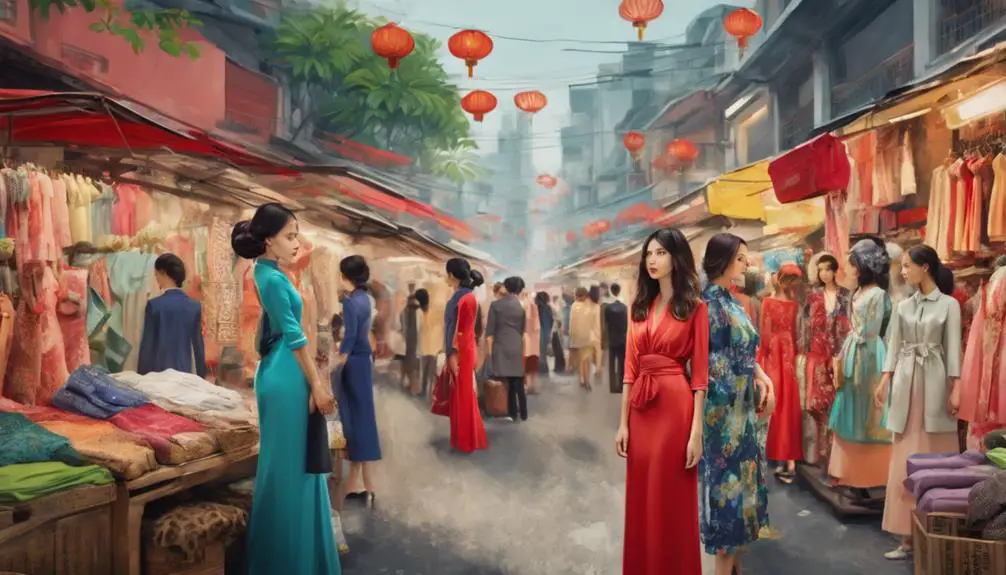
As you explore the market position of established Vietnamese fashion brands, you'll see how their rich historical legacies shape their current strategies. Brands like Viet Tien and May 10 have demonstrated resilience and adaptability in a fiercely competitive landscape, where over 200 foreign names vie for attention. Their innovative approaches and strategic partnerships not only enhance their market share but also showcase the dynamic evolution of domestic fashion in Vietnam.
Historical Brand Legacy
What makes established Vietnamese fashion brands stand out in today's competitive landscape? Their rich historical brand legacy plays an essential role. Brands like Viet Tien, May 10, and An Phuoc have thrived for decades, proving their resilience and adaptability.
- Viet Tien: Founded in 1975, it generated an impressive VND 8,464 billion in 2022.
- May 10: Since 1950, this iconic brand has maintained a significant presence, with revenues reaching VND 4,500 billion last year.
- An Phuoc: Established in 1989, it reported a profit after tax of VND 588 billion, showcasing strength in the textile sector.
- NEM and Seedcom: These brands adapt swiftly to market shifts, targeting specific demographics, guaranteeing they stay relevant.
- Emerging brands like YODY: Despite being newer, YODY's rapid expansion to 220 stores across 46 provinces highlights the competitive nature of Vietnamese fashion.
These established brands embody a blend of tradition and innovation, making them fundamental players in the industry. Their ability to navigate challenges while staying true to their roots is what sets them apart and guarantees their legacy continues to thrive in the vibrant world of Vietnamese fashion.
Competitive Market Strategies
Established Vietnamese fashion brands like Viet Tien, May 10, and An Phuoc leverage their rich histories to navigate today's competitive landscape. Viet Tien shines as a leader, recovering impressive revenue of VND 8,464 billion in 2022, showcasing its strong market position. May 10 isn't far behind, reporting VND 4,500 billion, while An Phuoc specializes in high-quality suits, generating VND 2,200 billion, establishing a solid foothold in the mid-range market segment.
To thrive, these brands invest in innovative marketing strategies, collaborating with local designers to attract younger consumers. By embracing modern trends, they guarantee their products resonate well with the evolving tastes of the market. Canifa, for instance, expanded its product lines, leading to a revenue growth of VND 1,400 billion. Additionally, brands like YODY have strategically increased their market coverage, boasting 220 stores across 46 provinces, enhancing consumer accessibility.
In this fast-paced fashion world, adaptability and strategic planning are essential. These established brands demonstrate resilience, proving that a blend of tradition and innovation can lead to success in a competitive market.
Brand Adaptation Trends
In the domain of Vietnamese fashion, brands like Viet Tien and May 10 are skillfully adapting to shifting consumer demands while maintaining their strong market positions. These established Vietnamese brands are embracing brand adaptation trends that foster resilience and revenue growth, even amidst fierce competition. For instance, An Phuoc is revamping its product offerings to enhance profit margins, while Canifa has achieved remarkable revenue growth by expanding its product lines.
Here are some key adaptation strategies being implemented:
- Expanding market coverage: YODY operates 220 stores across 46 provinces, reclaiming market share from foreign competitors.
- Collaborating with local designers: This partnership helps brands tap into unique styles and cultural relevance.
- Diversifying offerings: Seedcom manages multiple brands to capture a broader audience.
- Restructuring product lines: Adaptations to consumer preferences guarantee brands remain relevant.
- Utilizing influencer marketing: Engaging with popular figures helps brands connect with younger demographics.
These trends highlight how Vietnamese brands are not just surviving, but thriving, showcasing a proactive approach to meet evolving fashion demands and secure their market positions.
Future of Vietnamese Fashion Industry
Looking ahead, the Vietnamese fashion industry is set to thrive as it navigates a dynamic landscape shaped by innovation and cultural resurgence. With the textile and garment sector projected to contribute 12-16% of total export turnover, Vietnam exports a significant amount of fashion products, highlighting its vital role in the economy. As local brands restructure and innovate, they're reclaiming market share by adapting to evolving consumer preferences and enhancing their offerings, especially in the face of tough competition from over 200 foreign fashion brands.
Investment in marketing and brand awareness will be essential for these local brands to strengthen their market presence. You'll notice some leading enterprises of Vietnam are prioritizing sustainable growth while tackling challenges like decreasing domestic purchasing power. The emergence of innovative local designers, such as Fancí Club and Subtle Le Nguyen, showcases a shift towards unique, culturally-inspired fashion that resonates with contemporary consumers both at home and abroad.
Additionally, as awareness of cultural heritage grows, traditional Vietnamese attire is poised for international recognition. Efforts to promote ancient clothing in modern contexts through brands like Great Vietnam are key to this evolution. By embracing their roots and integrating them into fashion, Vietnam's future looks bright. So, keep an eye on this vibrant sector because the fusion of creativity and tradition promises to create a fashion landscape that's not only exciting but deeply rooted in the rich cultural heritage of the nation.
Frequently Asked Questions
What Is the Most Popular Clothing Brand in Vietnam?
The most popular clothing brand in Vietnam blends Vietnamese streetwear with traditional attire. You'll find modern designers embracing cultural influences while prioritizing sustainable fashion, appealing to diverse preferences and ensuring a vibrant fashion scene.
Which Fashion Brand Is the Oldest?
Imagine stepping into a world of vintage fashion, where cultural heritage meets brand evolution. If you're curious about the oldest fashion brand, look for one that weaves traditional textiles with historical influences, creating timeless elegance.
What Clothing Is Native to Vietnam?
Vietnam's traditional attire, like the Áo Dài and Áo Tắc, showcases cultural significance through diverse fabric materials and regional styles. You'll find modern adaptations blending heritage with contemporary fashion, celebrating Vietnam's rich textile history.
What Is the Biggest Vietnamese Brand?
When you think about the biggest Vietnamese brand, consider those embracing Vietnamese heritage while achieving global expansion. Brands focusing on sustainable fashion, using eco-friendly materials and celebrity endorsements are shaping the country's image in the fashion industry.
